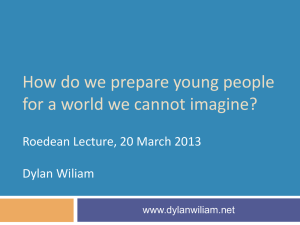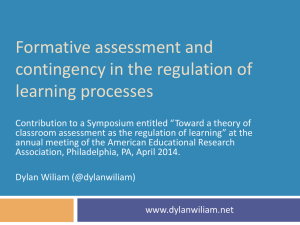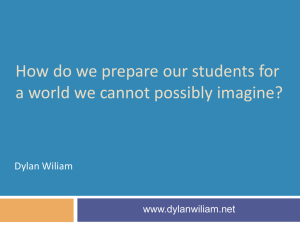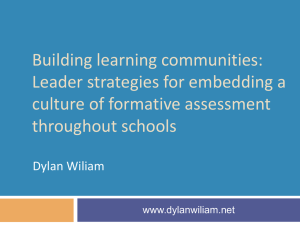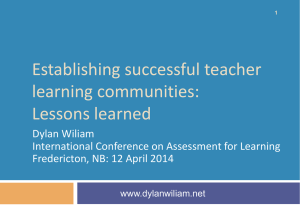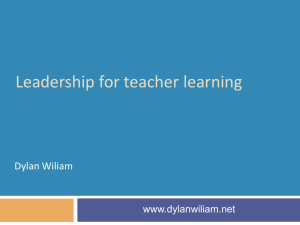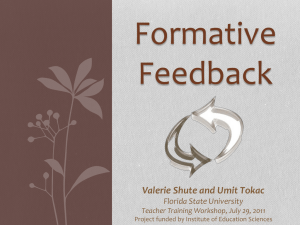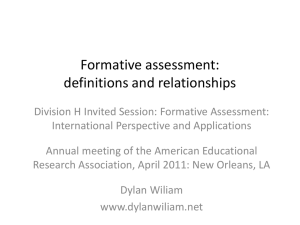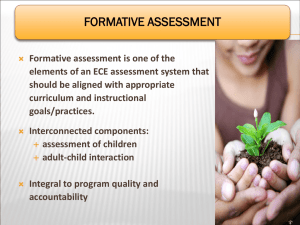Sustaining classroom formative assessment with TLCs
advertisement
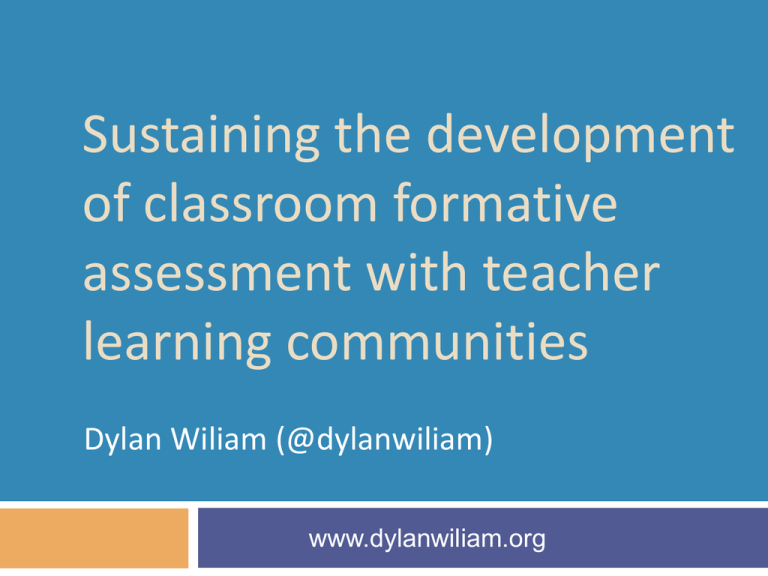
Sustaining the development of classroom formative assessment with teacher learning communities Dylan Wiliam (@dylanwiliam) www.dylanwiliam.org Overview: Science and Design 2 We need to improve student achievement This requires improving teacher quality Improving the quality of entrants takes too long So we have to make the teachers we have better Science We can change teachers in a range of ways Some will benefit students, and some will not Those that do involve changes in teacher practice Changing practice requires new kinds of teacher learning And new models of professional development Design The world of work is changing 3 Which kinds of skill are disappearing fastest from the workplace? A B Skill category Complex communication Expert thinking/problem solving C D E Non-routine manual Routine cognitive Routine manual Autor, Levy and Murnane (2003) Change 1969-1999 +14% +8% –5% –8% –3% Effective learning environments 4 A prevalent, mistaken, view Teachers create learning The teacher’s job is to do the learning for the learner A not so prevalent, not quite so mistaken, but equally dangerous view Only learners can create learning The teacher’s job is to “facilitate” learning A difficult to negotiate, middle path Teaching as the engineering of effective learning environments Key features: Create student engagement (pedagogies of engagement) Well-regulated (pedagogies of contingency) Develop disciplinary habits of mind (pedagogies of formation) The evidence base for formative assessment 5 Fuchs & Fuchs (1986) Natriello (1987) Crooks (1988) Bangert-Drowns, et al. (1991) Dempster (1991, 1992) Elshout-Mohr (1994) Kluger & DeNisi (1996) Black & Wiliam (1998) Nyquist (2003) Brookhart (2004) Allal & Lopez (2005) Köller (2005) Brookhart (2007) Wiliam (2007) Hattie & Timperley (2007) Shute (2008) Kingston & Nash (2011, 2015) Recent meta-analytic findings Content area N 95% confidence interval for effect size Lower Mean Upper 19 0.14 0.17 0.20 4 0.30 0.32 0.34 Science 17 0.06 0.19 0.31 Total 40 Mathematics English Language Arts Mean effect size ≈ 0.20 A big effect size Equivalent to a 50% to 70% increase in the rate of learning Kingston and Nash (2011, 2015) Formative assessment: a contested term 7 Long-cycle: Span: across units, terms Length: four weeks to one year Impact: Student monitoring; curriculum alignment Medium-cycle: Span: within and between teaching units Length: one to four weeks Impact: Improved, student-involved assessment; teacher cognition about learning Short-cycle: Span: within and between lessons Length: day-by-day: 24 to 48 hours minute-by-minute: five seconds to two hours Impact: classroom practice; student engagement Complementary processes 8 Data-driven PLCs Quality control Common assessments Improvement through better team work and systems Focus on individual outcomes for students Regular meetings focused on data 16 points on PISA (in two to three years) Classroom FA TLCs Quality assurance Highly structured meetings Improvement through increased teacher capacity Focus on teachers’ individual accountability for change Regular meetings focused on teacher change 30 points on PISA (in two to three years) Unpacking formative assessment 9 Where the learner is going Teacher Peer Learner Clarifying, sharing and understanding learning intentions Where the learner is How to get there Providing Engineering effective discussions, tasks, and feedback that moves learners activities that elicit forward evidence of learning Activating students as learning resources for one another Activating students as owners of their own learning Educational Endowment Foundation toolkit 10 Intervention Cost Quality of evidence Extra months of learning Feedback ££ +8 Metacognition and self-regulation ££ +8 Peer tutoring ££ +6 Early years intervention £££££ +6 One to one tuition ££££ +5 Homework (secondary) £ +5 Collaborative learning £ +5 Phonics £ +4 Small group tuition £££ +4 Behaviour interventions £££ +4 Digital technology ££££ +4 £ +4 Social and emotional learning Educational Endowment Foundation toolkit 11 Intervention Cost Quality of evidence Extra months of learning Parental involvement £££ +3 £££££ +3 Summer schools £££ +3 Sports participation £££ +2 Arts participation ££ +2 Extended school time £££ +2 Individualized instruction £ +2 After school programmes ££££ +2 £ +2 £££ +1 £ +1 Reducing class size Learning styles Mentoring Homework (primary) Educational Endowment Foundation toolkit 12 Intervention Cost Quality of evidence Extra months of learning Teaching assistants ££££ 0 Performance pay ££ 0 Aspiration interventions £££ 0 Block scheduling £ 0 School uniform £ 0 Physical environment ££ 0 Ability grouping £ -1 And one big idea 13 Where the learner is going Teacher Peer Learner Where the learner is How to get there Using evidence of achievement to adapt what happens in classrooms to meet learner needs An educational positioning system 14 A good teacher: Establishes where the students are in their learning Identifies the learning destination Carefully plans a route Begins the learning journey Makes regular checks on progress on the way Makes adjustments to the course as conditions dictate Formative assessment and other priorities 15 Formative assessment is an integral part of many current policy priorities: Framework for teaching (Danielson) Differentiated instruction (Tomlinson) Response to (instruction and) intervention A simple choice Keep searching for new ideas about what might and might not work, or Focus on making sure that we are what we already know will help students learn more is being done in our classrooms A model for teacher learning 17 Content, then process Content (what we want teachers to change): Evidence Ideas (strategies and techniques) Process (how to go about change): Choice Flexibility Small steps Accountability Support Supportive accountability 18 What is needed from teachers: A commitment to: The continual improvement of practice Focus on those things that make a difference to students What is needed from leaders: A commitment to engineer effective learning environments for teachers by: Creating expectations for continually improving practice Keeping the focus on the things that make a difference to students Providing the time, space, dispensation, and support for innovation Supporting risk-taking Strategies for change (Heath & Heath, 2010) 19 Direct the rider Follow the bright spots (malnutrition in Vietnam) Script the critical moves (1% milk, 25 points) Point to the destination (no dry holes) Motivate the elephant Find the feeling (gloves on the table) Shrink the change (five-minute room makeover) Grow your people (mindset) Shape the path Tweak the environment (popcorn study, one-click) Build habits (don’t tax the rider, action triggers) Rally the herd (free spaces in hospitals) 20 Teacher learning communities Professional learning communities 21 Professional Decision-making under uncertainty Accountable to a community of peers Learning Focused on improvement in student outcomes Communities Joint enterprise Mutual engagement Shared repertoire Why people shouldn’t work on their own 22 Only 2% of high school seniors believe their leadership skills are below average (College Board, 1976/1977) …and 25% of them believe they are in the top 1% in their ability to get along with others (College Board, 1976/1977) 93% of Americans and 69% of Swedes think they are above average drivers (Svenson, 1981) 94% of college professors report doing above average work (Cross, 1997) People think they are at lower risk than their peers for heart attacks, cancer, food poisoning, etc. (Weinstein, 1980) Strangers predict your IQ better than you do (Borkenau & Liebler, 1993) People believe they are more accurate than their peers at self-assessment (Pronin, Lin, & Ross, 2002) Strategies for teacher change 23 Direct the rider Follow the bright spots (volunteers vs. conscripts) Script the critical moves (structured meetings) Point to the destination (NCLB) Motivate the elephant Find the feeling (the moral imperative) Shrink the change (small steps) Grow your people (all teachers can improve) Shape the path Tweak the environment (time for teacher learning) Build habits (create routines and structures) Rally the herd (make new mistakes) Teacher learning communities 24 Plan that the TLC will run for two years. Identify 10 to 12 interested colleagues: Composition: Similar assignments (e.g., early years, math/science) Mixed subject/mixed phase Hybrid Secure institutional support for: Monthly meetings (75–120 minutes each, inside or outside school time) Time between meetings (two hours per month in school time): Collaborative planning Peer observation Any necessary waivers from school policies A “signature pedagogy” for teacher learning 25 Every monthly TLC meeting should follow the same structure and sequence of activities: Activity 1: Introduction (5 minutes) Activity 2: Starter (5 minutes) Activity 3: Feedback (25–50 minutes) Activity 4: New learning about formative assessment (20–40 minutes) Activity 5: Personal action planning (15 minutes) Activity 6: Review of learning (5 minutes) Every TLC needs a leader 26 The job of the TLC leader(s): To ensure that all necessary resources (including refreshments!) are available at meetings To ensure that the agenda is followed To maintain a collegial and supportive environment But most important of all: It is not to be the formative assessment “expert.” Peer observation 27 Run to the agenda of the observed, not the observer: Observed E.g., teacher specifies focus of observation: teacher wants to increase wait time. Observed Provides Observed teacher specifies what counts as evidence: observer with a stopwatch to log wait times. teacher owns any notes made during the observation. 28 How will we know if it’s working? We’ll know when it’s working when… 29 Leading indicators of success Teachers are given time to meet, and do so Teachers increasingly act as “critical friends” to others The prevalence of classroom formative assessment practices is increasing Students are more engaged in classrooms Teachers modify the techniques in appropriate ways, indicating an understanding of the underlying theory There is a shift in the ownership of the reform Lagging indicators of success Increased student achievement Possible foci for “Learning walks” 30 Foci Clear, valuable learning intentions for lesson Success criteria understood by students Students chosen at random Questions that make students think Students, not teacher, dominate discussions At least 80% students involved in answering questions All-student response system used Teacher waits three seconds after question Students support each others’ learning Students take responsibility for own learning Teacher gives oral formative feedback Evidence of comments that advance learning Teacher finds out what students learned Teaching adjusted after data collection Rating Exemplary practice Good practice Seen, but weak Non-existent Used inappropriately Key stakeholders’ reactions 31 Departmental sub-cultures Unions Professional associations Teachers’ aides Parents School Board members Community leaders Managing disappointments 32 Failure: opportunity for learning or blame Falling down: failing or learning? High-reliability organizations embrace failure $1m dollar club “A complaint is a gift” Group-work is hard for teachers, … and for teachers of teachers… To find out more… www.dylanwiliam.net Thank you www.dylanwiliam.net
